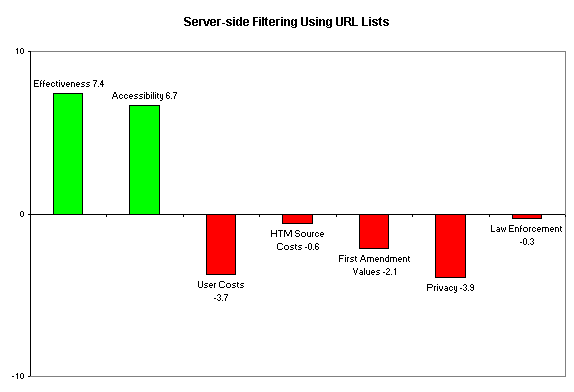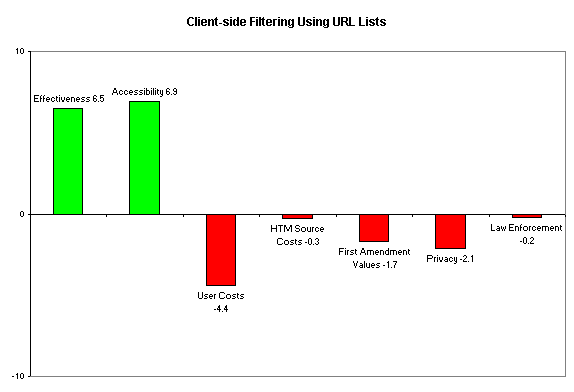|
B. Filtering/Blocking
3. Server-side filtering using URL8 lists
Voluntary use by Internet Service Providers and Online Services of server software that denies access to particular content sources (identified by uniform resource locators) that have been selected for blocking. The selection of the blocked list can rely upon automated processes, human review, and user options. The list of blocked URLs may or may not be disclosed. The list is regularly updated at the server.

Commentary
- Server-side filtering using URL lists is available now from numerous sources.
- Relative to other technologies, the best of these technologies can be highly effective in directly blocking access to global harmful to minors content on the Web and also on newsgroups, email and chat rooms. Server-side filters may be more easily implemented on a wide scale than client-side filters and may be more difficult for children to defeat.
- Due to rapid growth in Internet content, server-side filters using URL lists may not be perfectly effective in blocking. Server side technologies are accessible and easy to install and require few actions by the family. Different systems offer different degrees of customizability to reflect parental values, though many offer less control than client-side systems.
- Moderately costly to end-users, while costs to publishers of otherwise lawful harmful to minors materials are low.
- This technology raises First Amendment concerns because of its potential to be over-inclusive in blocking content. Concerns are increased because the extent of blocking is often unclear and not disclosed, and may not be based on parental choices. There is less of an impact on First Amendment concerns if filtering criteria are known by the consumer or other end-user and if filters are customizable and flexible.
- Central collection of preference and access information raises privacy concerns, as compared with client-side filtering systems.
- These systems could work with labeling regimes and greenspaces.
- There are significant concerns about First Amendment values when server-side filters are used in libraries and schools.
4. Client-side filtering using URL lists
Voluntary use by end users of software that causes the browser not to download content from specified content sources. The list of blocked sites may originate from both the software supplier and/or from decisions by the user. The list may be updated periodically by means of a download from the site of the software provider. The list may or may not be disclosed. A denial of access may be overridden with the use of a password controlled by a parent. The PC-based software may also filter out email or instant messaging from unapproved sources.

Commentary
- These systems are widely available from retail and other outlets. They require some effort by the end user to configure and update.
- Client-side filtering can be effective in directly blocking access to global harmful to minors content on the Web, in newsgroups, in email and in chat rooms. While often more flexible than server-side filters, client-side filters may be easier for children to defeat. Additionally, they require updating to keep pace with the global proliferation of harmful to minors content.
- Due to rapid growth in Internet content, client-side filters using URL lists may not be fully effective in blocking.
- This technology raises First Amendment concerns because of its potential to be over-inclusive in blocking content. Concerns are increased because the extent of blocking is often unclear and not disclosed. Still, many of these can be customized based on family choice.
- This technology is moderately costly to end users, while costs to publishers of harmful to minors material are low.
- The privacy impact of client-side filtering is lower than that for server-side filtering, as data resides locally.
- These systems have little impact on law enforcement.
5. Filtering (server- and client-side) using text-based content analysis
Voluntary use of some combination of PC-based software and server software that conducts (when necessary) real time analysis of the content of a web site and filters out content sources that fit some algorithm. The Commission assessed only text-based systems, which seem more promising than image analysis. Such a system may be able to analyze email and attachments. The end user may or may not be informed of the nature of the algorithm and may or may not have full information regarding what is being excluded.

Commentary
- This is an emergent technology that is not yet widely available.
- This technology may work well on text, but to be fully effective it must work on a combination of text and images. Application in real-time makes it easier for filtering to keep up with the growing and changing content on the Internet.
- This technology raises First Amendment concerns because of its potential to be over-inclusive in blocking content. Concerns are increased because the extent of blocking is often unclear and not disclosed. Client-side systems may be customized based on family choice.
- These technologies are moderately costly to consumers and other end-users. Adverse impacts to First Amendment values and costs to publishers stem from risk of over-inclusive blocking.
- Server-side products may raise privacy concerns based on the presence of centralized data about a user's preferences and access patterns.
8. URL" is the abbreviation for "universal resource locator" and refers to the address of an Internet site. For example, this CommissionŐs URL is "www.copacommission.org."
|
